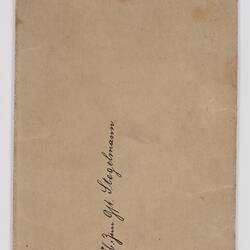Summary
Identity Pass issued to J. Stegelman in 1906 by the Royal German Navy. The pass states he will begin service with the Navy as of 18 February 1907 with Company 5, Shipyard 1.
Description of Content
Identity pass issued in 1906 by the Royal German Navy - company 5, shipyard 1. To J Stegelmann. Service to start 18/2/1907.
Physical Description
Card cover with sixteen paper pages inside. Cover has red and blue colours with naval emblem. Pages are white paper with black printed text. Personal details in pen with some purple stamps. All in German. Coming with it is a card envelope it slides into (has name in pen written on front)
Significance
Johannes Stegelman's story is a great example of more unorthodox migration. Jumping ship was a common way to start a new life in Australia, especially for sailors on merchant ships, and dates back to the 1850s gold rush with sailors jumping ship to head for the goldfields (John Simpson Kirkpatrick of 'Simpson and his donkey' fame arrived in Australia by jumping ship). Stegelman's objects all relate to his career in both the German Navy and the merchant navy including the hire document that brought him to Australia. The story is also interesting for its cross-cultural marriage and the bringing together of two very different migrant stories from different periods in time.
Gladys Leichti's objects and story represents the push to attract young British girls for domestic service in the 1920s and the role of philanthropic organizations such as the Salvation Army in meeting this demand.
More Information
-
Collecting Areas
Migration & Cultural Diversity, Public Life & Institutions, Transport
-
Acquisition Information
Donation from Margaret Steglman, 29 Nov 2006
-
Issued To
-
Other Association (See Comments)
Germany, 18 Feb 1907
Service with the Royal German Navy to commence from this date. -
Classification
Migration, Processing - planning & departure, Identification
-
Category
-
Discipline
-
Type of item
-
Overall Dimensions
14.6 cm (Length), 9.6 cm (Width)
-
Keywords
Apprenticeships, German Communities, German Immigration, Immigration, Merchant Seamen, Shipboard Travel, Shipping Companies, Shipping Industry, Trades, Tradespeople




